The History Of MG

MG is a British sports car brand founded in 1924.
MG is best known for two-seat open sports cars, but MG also produced saloons and coupés. More recently, the brand has also been used to designate sportier versions of other models belonging to the parent company.
The brand was in continuous use (barring the years of the Second World War) for 56 years after its inception. Production of predominantly two-seater sports cars was concentrated at a factory in Abingdon, some 10miles (16km) south of Oxford. The BMC competition department was also based at the Abingdon plant and produced many winning rally and race cars. In the autumn of 1980, however, the Abingdon factory closed and MGB production ceased.
Between 1982 and 1991, the MG marque was revived on faster versions of Austin Rover's Metro, Maestro and Montego ranges. After an interval of barely one year, the MG marque was revived again, this time on the MG RV8 — an updated MGB Roadster with a Rover V8 engine, which was produced in low volumes.
The "real" revival came in the summer of 1995, when the high volume MG F two-seater roadster was launched. This was an instant hit with buyers, and sold in volumes which had been unthinkable on affordable two-seaters since the 1970s. The MG F was subsequently replaced under BMW's ownership by the "02 Model Year" revised version, otherwise known as the X40 project.
MG was one half of the MG Rover group in May 2000, when BMW 'broke up' the Rover Group. This arrangement saw the return of MG badges on sportier Rover-based cars, but production ceased in April 2005 when MG Rover went into administration.
The assets of MG Rover were bought by Chinese carmaker Nanjing Automobile in July 2005 who themselves were bought by SAIC in December 2007.
In 2007 pilot production of the MG TF resumed at Longbridge. Production of the MG 7 large sports saloon also started in China, and in 2008 the range is set to expand with the arrival of the smaller MG 3 and MG 5 hatchbacks.
References -
MG got its name from "Morris Garages", a dealer of Morris cars in Oxford which began producing its own customised versions to the designs of Cecil Kimber who had joined the company as its Sales Manager in 1921 and was promoted to General Manager in 1922. Kimber remained as General Manager until 1941 when he fell out with Lord Nuffield over procuring wartime work. Kimber died in 1945 in a freak railway accident.
There is some debate over when MG started. The company itself stated it to be 1924[citation needed], although the first cars bore both Morris and MG badges and a reference to MG with the octagon badge appears in an Oxford newspaper from November 1923. Others dispute this and believe that MG only properly began trading in 1925.
The first cars which were rebodied Morris models using coachwork from Carbodies of Coventry and were built in premises in Alfred Lane, Oxford but demand soon caused a move to larger premises in Bainton Road in September 1925 sharing space with the Morris radiator works. Continuing expansion meant another move in 1927 to a separate factory in Edmund Road, Cowley, Oxford, near the main Morris factory and for the first time it was possible to include a production line. In 1928 the company had become large enough to warrant an identity separate from the original Morris Garages and the M.G. Car Company Limited was established in March of that year and in October for the first time a stand was taken at the London Motor Show. Space again soon ran out and a search for a permanent home led to the lease of part an old leather factory in Abingdon, Oxfordshire in 1929, gradually taking over more space until production ended there in 1980.
Originally owned personally by William Morris, the company was sold to Morris Motors (itself part of the Nuffield Organisation) in 1935; a change that was to have serious consequences for the company, particularly its motor-sport activities.
BMC
MG was absorbed into the British Motor Corporation in 1952. Long-time service manager John Thornley took over as General Manager, guiding the company through its best years until his retirement in 1969. Under BMC, several MG models were no more than badge-engineered versions of other marques, with the main exception being the small MG sports cars.
Amidst a mix of economic, internal and external politics, the Abingdon factory was shut down as part of the ruthless programme of cutbacks necessary to turn BL around after the turbulent times of the 1970s. Though many plants were closed, none created such an uproar among workers, dealers, clubs and customers as this closing did. Years later, Sir Michael Edwardes expressed regret about his decision. Later forms of MGs built by BL's Austin Rover Group were often badge-engineered Austins, and were made at the Longbridge plant. As of 2003, the site of the former Abingdon factory was host to McDonalds and the Thames Valley Police with only the former office block still standing. The headquarters of the MG Car Club (established 1930) is situated next door.
BMW
After BL became the Rover Group in 1986, ownership of MG passed to British Aerospace in 1988 and then in 1994 to BMW. BMW sold the business in 2000 and MG became part of the MG Rover Group based in Longbridge, Birmingham. The practice of selling unique MG sports cars alongside badge-engineered models (by now Rovers) continued. The Group went into receivership in 2005 and car production was suspended on 7 April 2005.
In 2006, it was reported that Project Kimber led by David James had entered talks with Nanjing to buy the MG brand in order to produce a range of sports cars based on the discontinued Smart Roadster design by DaimlerChrysler. No agreement was reached and it was later announced that the re-launched Smart Roadster would bear the AC name.
Nanjing and SAIC
On 22 July 2005, the Nanjing Automobile Group purchased the rights to the MG name and the assets of the MG Rover Group for £53 million. Its new Chinese owners, stated that the brand would stand for something new in China, as MG general manager Zhang Xin said: "We want Chinese consumers to know this brand as 'Modern Gentleman'. To see that this brand represents grace and style." In Europe it still stands for "Morris Garages".
Nanjing restarted production of the MG TF and ZT ranges in early 2007. The TF is being built at Longbridge, while the ZT (now the MG 7) is being assembled in China.
On 11 July 2006 Nanjing announced the development of a TF sports coupé. A new plant was to be built in Ardmore, Oklahoma to build the car, accounting for roughly 60% of TF output worldwide. A new development centre would also be opened in the United States, located at the University of Oklahoma. The Longbridge plant in the UK was to continue to build TFs as well, and a third plant in Pukou, at Jiangsu Province in China, would produce the ZT and ZR. According to Nanjing, MGs were to go on sale in the United States in the early summer of 2008. However, in an interview in August, 2008, NAC MG UK's Sales and Marketing Director, Gary Hagen stated that the Oklahoma deal had fallen through. He also said that there would be no immediate return to the US market as they would first be concentrating on the UK and Ireland followed by the rest of Europe.
NAC entered talks with SAIC supported by the Chinese government about a merger. Their cars, MG 7 (NAC) and Roewe 750 (SAIC) share mechanical features. The takeover was completed on 26 December 2007.
The MG range was relaunched in Britain during 2008, with the TF, now called the TF LE500, an updated version of the original model. The new MG 3, MG 5 and MG 7 ranges will be updated versions of the previous MG ZR, MG ZS and MG ZT ranges. In November 2008 MG returned to the Americas with the start of sales of the MG550 and MG750 in Chile.
The earliest model, the 1924 MG 14/ 28 consisted of a new sporting body on a Morris Oxford chassis. This car model continued through several versions following the updates to the Morris. The first car which can be described as a new MG, rather than a modified Morris was the 18/ 80 of 1928 which had a purpose designed chassis and the first appearance of the traditional vertical MG grille. A smaller car was launched in 1929 with the first of a long line of Midgets starting with the M-Type based on a 1928 Morris Minor chassis. MG established a name for itself in the early days of the sport of international automobile racing. Beginning before and continuing after World War II, MG produced a line of cars known as the T-Series Midgets which, post-war, were exported worldwide, achieving better than expected success. These included the MG TC, MG TD, and MG TF, all of which were based on the pre-war MG TB, with various degrees of updating.
MG departed from its earlier line of Y-Type saloons and pre-war designs and released the MGA in 1955. The MGB was released in 1962 to satisfy demand for a more modern and comfortable sports car. In 1965 the fixed head coupé (FHC) followed: the MGB GT. With continual updates, mostly to comply with increasingly stringent United States emissions and safety standards, the MGB was produced until 1980. Between 1967 and 1969 a short-lived model called the MGC was released. The MGC was based on the MGB body, but with a larger (and, unfortunately, heavier) six-cylinder engine, and somewhat worse handling. MG also began producing the MG Midget in 1961. The Midget was a re-badged and slightly restyled second-generation Austin-Healey Sprite. To the dismay of many enthusiasts, the 1974 MGB was the last model made with chrome bumpers due to new United States safety regulations; the 1974½ bore thick black rubber bumpers that some claimed ruined the marque MGB. As with the MGB, the Midget design was frequently modified until the Abingdon factory closed in October 1980 and the last of the range was made. The badge was also applied to versions of BMC saloons including the BMC ADO16, which was also available as a Riley, but with the MG pitched as slightly more "sporty".
The marque lived on after 1980 as British Leyland (later Austin Rover Group), the then-owner, continued to place the MG badge on a number of Austin saloons including the Metro, Maestro, and Montego. In New Zealand, the MG badge even appeared on the late 1980s Montego estate, called the MG 2.0 Si Wagon. There was a brief competitive history with a mid-engined, six-cylinder version of the Metro. The MG Metro finished production in 1990 on the launch of a Rover-only model. The MG Maestro and MG Montego remained on sale until 1991, when production of these models was pruned back in order for Rover to concentrate on the more viable 200 Series and 400 Series.
The Rover Group revived the two-seater with the MG RV8 in 1992. The all-new MGF went on sale in 1995, becoming the first mass-produced "real" MG sports car since the MGB ceased production in 1980.
In May 2000, BMW sold off the Rover group after a six-year ownership and its new owners were the Phoenix Consortium. The Land Rover and Mini marques were not included in the deal, and the new-look group included just the MG and Rover models. The MG range was expanded in the summer of 2001 with the introduction of three Rover-based sports models. The MG ZR was based on the Rover 25, the MG ZS on the Rover 45, and the MG ZT/ ZT-T on the Rover 75.
The MG Rover Group purchased Qvale, which had taken over development of the De Tomaso Bigua. This car, renamed the Qvale Mangusta and already approved for sale in the U.S., formed the basis of the MG XPower SV, an "extreme" V8-engined sports car. It was revealed in 2002 and went on sale in 2004.
From its earliest days MGs have been used in competition and from the early 1930s a series of dedicated racing cars such as the 1931 C-Type and 1934 Q-type were made and sold to enthusiasts who received considerable company assistance. This stopped in 1935 when MG was formally merged with Morris Motors and the Competition Department closed down. A series of experimental cars had also been made allowing Captain George Eyston to take several world speed records. In spite of the formal racing ban, speed record attempts continued with Goldie Gardner exceeding 200mph (320km/ h) in the 1100cc EX135 in 1939.
After World War II record breaking attempts restarted with 500cc and 750cc records being taken in the late 1940s. A decision was also taken to return to racing and a team of MGAs was entered in the tragedy-laden 1955 Le Mans 24 hour race, the best car achieving 12th place.
Prior to the use of the Toyota Tundra in the Craftsman Truck Series, MG was reported as the last foreign brand to be used in NASCAR. It was driven in 1963 by Smokey Cook.
In 2001 MG re-launched their motor sport campaign to cover the 24 Hours of Le Mans (MG-Lola EX257), British Touring Car Championship (BTCC) (MG ZS), British and World Rally Championships and MG Independent British Rally Championship (MG ZR). The Le Mans team failed to win the endurance race in 2001 and 2002 and quit in 2003. MG Sport+Racing raced in the British Touring Car Championships with the MG ZS between 2001–2003 as a factory team. In 2004 WSR raced the MG ZS as a privateer team and still race in the series today with many wins to date. After three years without a major sponsor, WSR teamed up with RAC in 2006 and the team was called Team RAC. The MG British Rally Challenge still runs today despite the liquidation in 2005.
In 2004 plans to race in the Deutsche Tourenwagen Masters (DTM) with a heavily modified V8 powered ZT supertouring car were cancelled due to MG Rover's liquidation in April 2005.
In 2007, a surprise announcement was made that a Super 2000 (S2000) rally car has been prepared in conjunction with rally experts MSD, who used to manage the Hyundai works World Rally team. This is the first sporting step the reformed company has made. Testing has been carried out on the MG ZR based car & it is expected to enter competition in 2008.
- Sports car
- 1924-1929 MG 14/ 28
- 1924-1929 MG 14/ 40
- 1929-1932 MG M-type Midget
- 1931-1932 MG C-type Midget
- 1931-1932 MG D-type Midget
- 1931-1932 MG F-type Magna
- 1932-1934 MG J-type Midget
- 1932-1934 MG K-type Magnette
- 1933-1934 MG L-type Magna
- 1934-1936 MG N-type Magnette
- 1934-1936 MG P-type Midget
- 1936-1939 MG TA Midget
- 1939-1940 MG TB Midget
- 1945-1950 MG TC Midget
- 1950-1953 MG TD Midget
- 1953-1955 MG TF Midget
- 1955-1962 MGA
- 1961-1979 MG Midget
- 1962-1980 MGB
- 1968-1969 MGC
- 1973-1976 MGB GT V8
- 1992-1995 MG RV8
- 1995-2005 MG F
- 2002-2005 MG TF
- 2007- MG TF
- Subcompact car
- 1982-1990 MG Metro
- 2001-2005 MG ZR
- 2007- MG 3
- Compact car (Small saloons)
- 1933-1934 MG KN
- 1962-1968 MG 1100
- 1967-1973 MG 1300
- Midsize car (Medium saloons)
- 1924-1927 MG 14/ 28
- 1927-1929 MG 14/ 40
- 1928-1933 MG 18/ 80
- 1937-1939 MG VA
- 1947-1953 MG Y-type
- 1953-1956 MG Magnette ZA
- 1956-1958 MG Magnette ZB
- 1959-1961 MG Magnette Mk. III
- 1961-1968 MG Magnette Mk. IV
- 1983-1991 MG Maestro
- 1985-1991 MG Montego
- 2001-2005 MG ZS
- 2007- MG 5
- Full-size car (Large saloons)
- 1936-1939 MG SA
- 1938-1939 MG WA
- 2001-2005 MG ZT
- 2007- MG 7
- Supercar
- 2002-2005 MG XPower SV
- Racing cars
- 1930-1931 MG 18/ 100 "Tigress"
- 1934 MG Q-type
- 1935 MG R-type
- Concept car
- 1985 MG E-XE
- 2007 MG E-XR
- Vans
- 1980s MG Metro van
- 2003-2005 MG Express
From Wikipedia, the free encyclopedia
More About MG
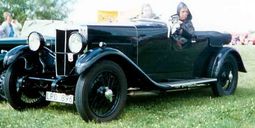



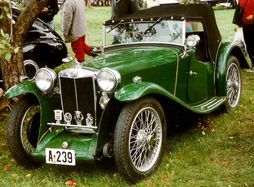
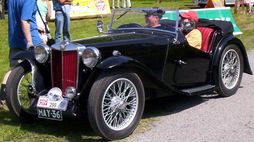
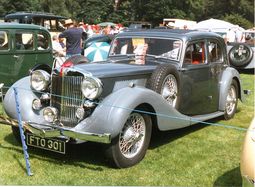
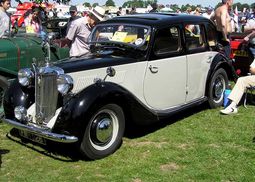
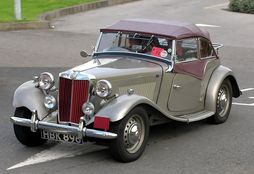

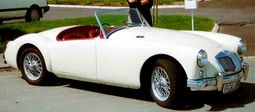
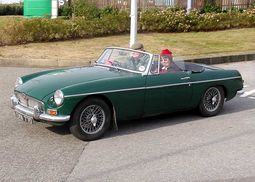
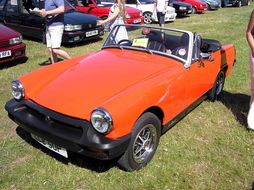
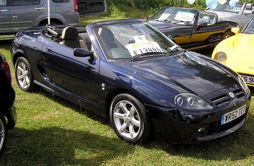
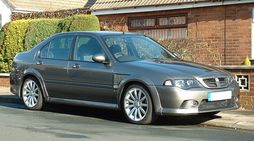
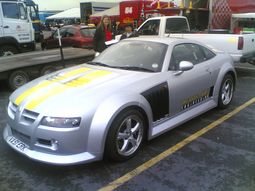
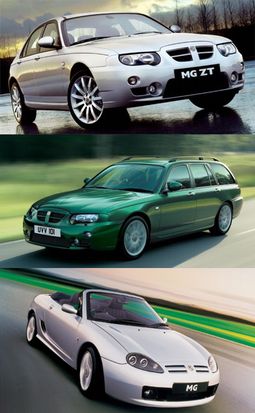

|